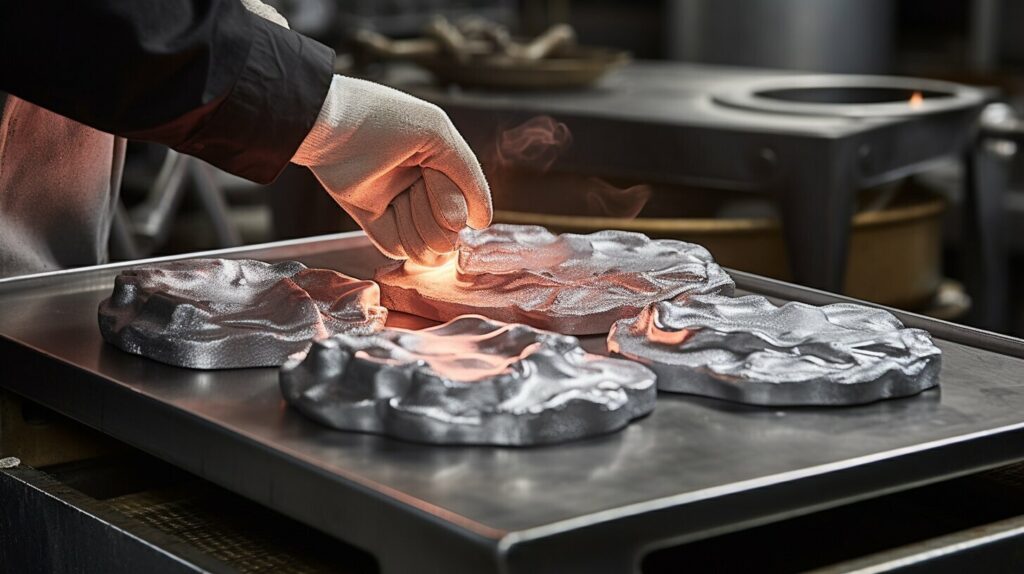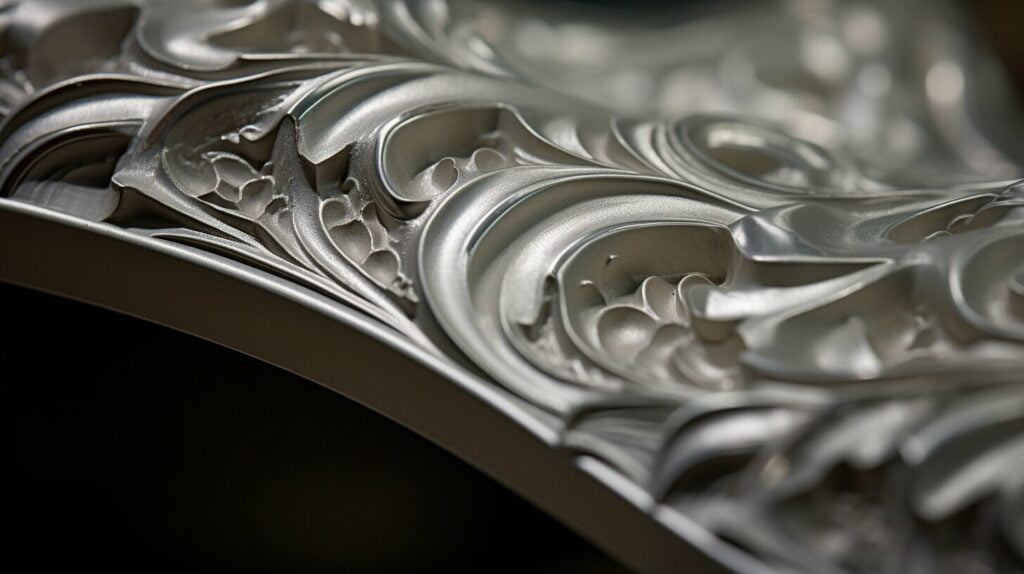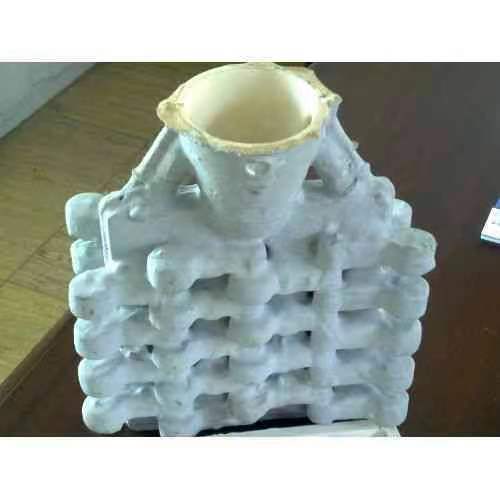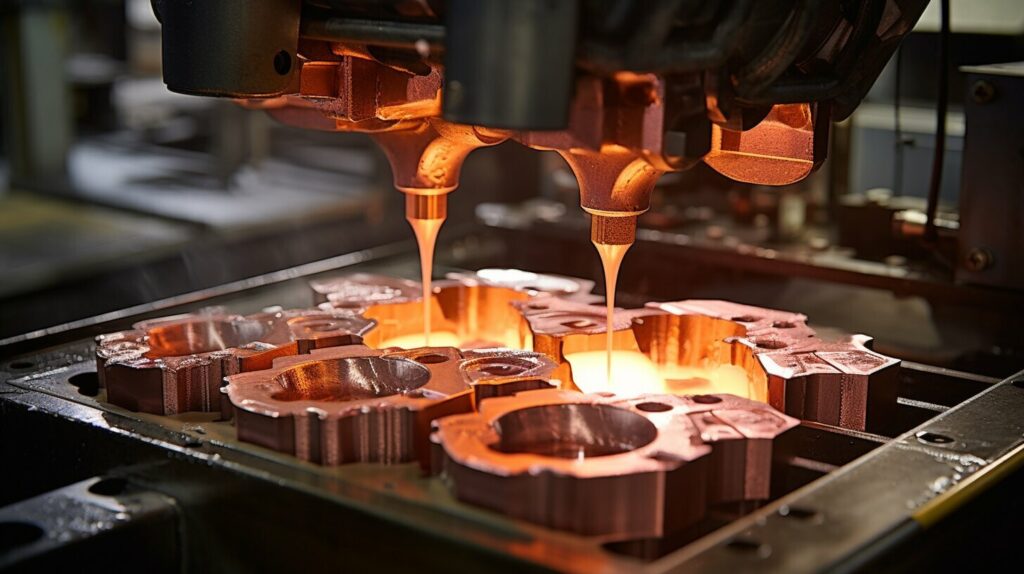Investment casting is a popular metal casting method that offers numerous advantages, particularly in the production of stainless steel components. This process involves creating a ceramic mold around a wax pattern, which is then melted away, leaving a cavity for molten metal to be poured into. The result is a high-precision, complex component that boasts superior strength and durability.

Key Takeaways
- Investment casting offers exceptional precision and the ability to create complex shapes with tight tolerances.
- Stainless steel investment casting is widely used in industries such as aerospace, automotive, and medical.
- The investment casting process results in parts and components with superior strength and durability.
- Investment casting can produce smooth surface finishes and achieve high dimensional precision.
- While investment casting may have higher manufacturing costs compared to other casting methods, the benefits often outweigh the additional costs.
Understanding Investment Casting
Investment casting, also known as lost wax casting, is a precision casting process used to create complex and intricate shapes with high accuracy. It is a versatile and reliable manufacturing process, making it a popular choice across various industries. The investment casting process involves creating a ceramic mold around a wax pattern, which is then melted away, leaving a cavity for molten metal to be poured into. This process is used to produce parts and components that would be difficult or impossible to create with other casting processes such as sand casting or die casting.
| Investment casting | Sand casting | Die Casting |
|---|---|---|
| Creates parts with intricate details and high dimensional accuracy | Produces rougher surface finish and less precise parts | Produces accurate and repeatable parts with a higher production rate |
| Produces a smooth surface finish | Appropriate for larger parts and components | Material limitations – typically reserved for non-ferrous metals |
| Can use a variety of metals and alloys, including ferrous metals | Less expensive process, suitable for simpler designs and larger quantities | Most appropriate for parts that require high accuracy and repeatability |
Compared to other casting processes, investment casting can achieve tighter tolerances and superior surface finishes. The use of specialized equipment and ceramic slurry enables investment casting to create parts and components with high precision and consistent quality. Additionally, investment casting is ideal for producing components in a broad range of sizes and shapes, including complex geometries such as turbine blades and medical implants.

During the investment casting process, molten metal is poured into the ceramic mold, where it sets and solidifies to form the final product. This process is typically used with metals such as stainless steel, aluminum, and titanium, although other metals and alloys can also be used. The resulting parts and components can be used in various industries, including aerospace, automotive, medical, and more.
Conclusion
Investment casting is a versatile and precise manufacturing process that offers numerous advantages over other casting methods. Its ability to create intricate shapes with high dimensional accuracy makes it a popular choice in producing parts and components that demand high precision and consistent quality. In the next section, we’ll explore the specific advantages of investment casting in more detail.
Advantages of Investment Casting
At its core, investment casting is a metal casting process that utilizes a ceramic slurry and specialized equipment to create complex shapes with tight tolerances and high precision. Compared to other metal casting methods, investment casting offers several advantages that make it a popular choice for manufacturing metal components.
| Advantage | Description |
|---|---|
| Tight Tolerances | Investment casting allows for the creation of parts with tighter tolerances than other casting methods. This is achieved by using precision molds and a specialized casting process that ensures high dimensional accuracy. |
| Precision Casting | Investment casting is perfect for creating metal components with intricate details, such as those found in aerospace and medical applications. The use of wax patterns and ceramic molds allows for the creation of complex shapes with incredible precision. |
| Refractory Material | The use of refractory material, such as ceramics, in investment casting allows for even tighter tolerances compared to other casting methods. The material can withstand high temperatures, ensuring accurate and consistent results during the casting process. |
Overall, investment casting is a versatile and reliable metal casting method that offers many advantages over other casting processes. By using ceramic slurry, specialized equipment, and precise molds, investment castings can be made with tight tolerances and high precision, making it an ideal choice for creating metal components for a broad range of applications.

Applications of Stainless Steel Investment Casting
Stainless steel investment casting is widely used in multiple industries to create complex parts and components. As an investment casting project, it offers several advantages over other casting methods, including the ability to create intricate shapes and designs with high dimensional precision.
Some of the industries that commonly use stainless steel investment casting include aerospace, automotive, and medical. In aerospace, investment casting is used to manufacture turbine blades and other critical components that require high strength and durability. In the automotive industry, investment casting is used for parts such as engine components, suspension systems, and braking systems. In the medical industry, investment casting is used to produce implantable medical devices such as bone screws and hip replacements.
Compared to other casting processes such as sand casting and die casting, stainless steel investment casting offers several benefits. The use of a ceramic mold allows for the creation of intricate shapes and designs that would be difficult or impossible to achieve with other casting methods. Additionally, the ceramic mold enables the production of parts with tighter tolerances and smoother surface finishes than other casting processes.
While other casting methods may be more suitable for certain types of components, stainless steel investment casting remains a popular and versatile option for a broad range of applications.

Surface Finish and Dimensional Precision in Investment Casting
Investment casting, also known as lost wax casting, is a casting process that offers superior surface finish and dimensional precision compared to other casting methods.
The investment casting cycle involves creating a ceramic mold around a wax pattern, which is then melted away, leaving a cavity for molten metal to be poured into. This process allows for excellent surface finishes, as the ceramic shell provides a smooth surface for the final casting.
Additionally, investment casting allows for the use of cobalt alloys, which are known for their high strength and durability. These alloys can be used to produce complex shapes, over a broad range of sizes.
When compared to sand castings or similar manufacturing methods, investment casting offers tighter tolerances and greater dimensional accuracy. This makes investment casting ideal for parts and components that require high precision, such as those used in the aerospace and medical industries.
Whether you need a simple or complex shape, investment casting can provide the surface finish and dimensional precision you require.

Investment casting is an ideal choice for creating stainless steel components, offering superior strength and durability. In the next section, we will explore the advantages and disadvantages of investment casting in greater detail.
Advantages and Disadvantages of Investment Casting
As with any manufacturing process, investment casting has its own set of advantages and disadvantages. In this section, we will provide a balanced overview of these factors.
Advantages of Investment Casting
Investment casting’s use of wax patterns makes it possible to create intricate and complex shapes that would be impossible or cost-prohibitive through other casting methods. Additionally, investment casting provides a superior surface finish compared to sand castings, allowing for better surface quality and smoother finishes. The use of ceramic molds and specialized equipment also enables tighter tolerances in the manufacturing process, making it possible to achieve high levels of dimensional precision.

Furthermore, investment casting is a versatile casting method used to cast a broad range of materials, including stainless steel, aluminum alloys, cobalt alloys, and more. The use of multiple patterns can also result in higher output efficiency and greater cost-effectiveness.
Disadvantages of Investment Casting
While investment casting offers many advantages, it also has potential drawbacks. For example, additional machining may be required to achieve the desired final shape, resulting in higher costs compared to other casting methods. Additionally, investment casting requires specialized equipment and expertise, which can lead to longer lead times and higher manufacturing costs.
Another potential challenge of investment casting is the fragility of wax patterns, which can be damaged during the mold-making process. The dependence on the wax pattern also means that the process can be impacted by factors such as temperature and humidity.
Overall, while investment casting may not be the best option for every manufacturing project, its ability to achieve complex shapes and superior surface finishes make it a valuable process for many industries.
Materials for Investment Casting
Investment casting isn’t limited to just stainless steel; it can also be used for a wide range of other materials, including ferrous metals such as carbon steel, alloy steel, tool steel, and ductile iron. In addition, investment casting can be used for non-ferrous metals like aluminum, brass, and bronze.
One of the advantages of investment casting is the ability to achieve a variety of surface finishing options. Common surface finishes include sand blasting, polishing, and powder coating.
To create smooth surface finishes, multiple patterns can be used to create a ceramic shell, which is then used to cast the metal. The patterns can be made using wax, plastic, or even metal, depending on the material being cast.
The use of ceramic shells in investment casting also contributes to the precision and accuracy of the final product, as the ceramic coating can achieve tighter tolerances than other casting methods. The ceramic shell also provides excellent heat resistance, making it ideal for casting materials that require high-temperature processing.

Overall, investment casting provides a versatile and reliable casting method for a wide range of materials and industries. Its ability to achieve tight tolerances, precision casting, and smooth surface finishes make it a popular choice for complex parts and components.
Conclusion
At our company, we understand the importance of using the right casting method to produce reliable and durable components. Investment casting, particularly stainless steel investment casting, offers numerous advantages that cannot be achieved through other casting methods. From its exceptional strength to superior dimensional precision, investment casting proves to be a versatile and reliable manufacturing process for a wide range of industries. Its ability to create complex shapes with tight tolerances and high precision makes it an attractive option for creating intricate parts and components for aerospace, automotive, medical, and other industries. While investment casting may require specialized equipment and additional manufacturing costs, the benefits it offers, such as the ability to create smooth surface finishes and intricate details using wax patterns, make it a valuable and worthwhile investment. As technology and techniques continue to advance, we remain committed to staying at the forefront of the investment casting industry. With our expertise in creating precise and durable components, we are confident in our ability to deliver beyond our clients’ expectations. In conclusion, the advantages and applications of investment casting, particularly in stainless steel casting, are undeniable. Its ability to achieve high dimensional precision and superior strength makes it a reliable and versatile choice for creating intricate and durable components. We stand by our investment casting process as a valuable manufacturing solution for a broad range of industries, and we look forward to continuing to push the boundaries of what is possible through investment casting.
FAQ
Q: What are the advantages and applications of investment casting?
A: Investment casting offers superior strength, exceptional durability, and a broad scope of applications. It is commonly used in industries such as aerospace, automotive, medical, and more.
Q: How does investment casting work?
A: Investment casting, also known as lost wax casting, involves creating a ceramic mold around a wax pattern. The wax is then melted away, leaving a cavity for molten metal to be poured into.
Q: What are the advantages of investment casting?
A: Investment casting allows for the creation of complex shapes with tight tolerances and high precision. It also enables the use of refractory materials, resulting in even tighter tolerances compared to other casting methods.
Q: In what applications is stainless steel investment casting commonly used?
A: Stainless steel investment casting is widely used for creating parts and components in industries such as aerospace, automotive, medical, and more. It is ideal for producing durable and intricate stainless steel components.
Q: How does investment casting achieve surface finish and dimensional precision?
A: Investment casting uses a casting cycle that contributes to superior surface finishes compared to other casting methods. Additionally, the use of cobalt alloys and the ability to create complex shapes allow for dimensional precision over a broad range of sizes.
Q: What are the advantages and disadvantages of investment casting?
A: Investment casting offers benefits such as the ability to create intricate details using wax patterns. However, it may require additional machining and has higher manufacturing costs compared to other casting methods.
Q: What materials can be used in investment casting?
A: Investment casting can be performed with various materials, including ferrous metals such as stainless steel. Other materials can also be cast using this method, and multiple patterns can be used to create ceramic shells for smooth surface finishes.
Q: What makes stainless steel investment casting a reliable manufacturing process?
A: Stainless steel investment casting offers superior strength, exceptional durability, and the ability to achieve high dimensional precision. Its versatility and reliability make it a valuable option for creating intricate and durable stainless steel components.
At KT-Foundry, we grasp the significance of precision and meticulousness in crafting tailored castings for our valued clients. Our team comprises seasoned engineers and skilled technicians who leverage cutting-edge technology and advanced techniques to ensure that each casting aligns with your exact specifications.


